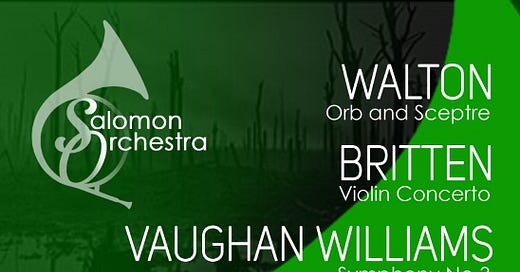Walton, Britten, and Vaughan Williams at Smith Square Hall, 7:30pm, 14th June, 2025
This year is the 80th anniversary of the end of the Second World War. In this concert, Salomon presents three distinct pieces that, each in their own way, resonate with themes of national identity, of human experience in times of conflict, and reflection on its aftermath.
The programme opens with William Walton's Orb and Sceptre, a celebratory march composed for the coronation of Queen Elizabeth II in 1953. It follows the pattern of earlier concert marches by Elgar and Walton himself: opening with a brisk and spirited section characterised by bright trumpet fanfares before launching into a syncopated march. A more subdued melody on the strings follows before the march theme returns, building to a final, majestic appearance of the trio theme, this time with the full orchestra, concluding with a short, fast coda. While it was composed some eight years after the end of the Second World War, Orb and Sceptre embodies a sense of national continuity and tradition in the post-war era, marking a moment of renewed hope and royal ceremony.
If you would like to play with the Salomon Orchestra, then please
email admin@salomonorchestra.org with your details and experience.
We are always keen to find new players.
Benjamin Britten's Violin Concerto was completed in 1939, in the early weeks of the Second World War, and stands as Britten's only work in this genre. Though possessing virtuosic elements, the concerto is also marked by lyrical and elegiac passages, undoubtedly reflecting the composer's growing concern with the escalating world hostilities. It opens with a series of striking timpani strokes, followed by the entry of the solo violin with a song-like lament soaring above the orchestra. This initial mood is contrasted with a more militaristic and percussive secondary theme. Composed on the cusp of and during the initial stages of the war, the concerto can be heard as a personal and artistic response to the looming conflict, capturing both the beauty threatened by war and the unsettling presence of impending aggression.
Ralph Vaughan Williams's Symphony No. 3, known as the Pastoral Symphony, was completed in 1922 and is a profound reflection on Vaughan Williams's experiences during the First World War. Despite its title, the symphony is not intended to evoke tranquil English landscapes but rather the war-ravaged French countryside where Vaughan Williams served in the Royal Army Medical Corps. The inspiration for the trumpet cadenza in the second movement - which has been described as a "spectral Last Post", further underscoring the symphony's connection to wartime loss - came from hearing a bugler during the war inadvertently play a seventh instead of an octave. The symphony's overall tone is reflective and often melancholic, serving as a subtle but deeply felt requiem for a generation lost to the Great War. A wordless solo soprano or tenor voice is added to the orchestral texture in the finale, which is often interpreted as a lament for the fallen. It took time for listeners to fully recognise the symphony's character as a requiem, with the wartime allusions becoming more widely understood after the Second World War.
As we commemorate the 80th year since the end of WWII, this symphony serves as a poignant reminder of the enduring impact of war and the importance of remembrance.




